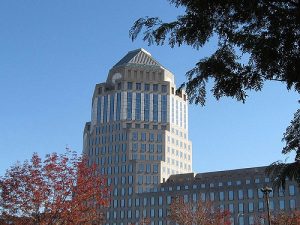
P&G’s HQ. Image via Flickr/elycefeliz, CC BY-NC-ND 2.0
After a nail biter of a recount in a fiercely contested proxy battle, activist investor Norman Peltz narrowly won a seat on the board of Procter and Gamble, the Cincinnati-based consumer products giant known for classic household brands like Pampers, Tide, and Crest toothpaste. Everyone agrees that the company has been underperforming. The CEO argues that the turnaround is already in progress, but Peltz wants more aggressive action. (P&G may be challenging, or at least reviewing, the recount).
This immediately raises the question of what Peltz’s victory means for the future of P&G in Cincinnati. You don’t need to rely on my speculation entirely here. P&G CEO David Taylor told the Cincinnati Enquirer that Peltz “suggested moving business units and jobs out of the Cincinnati headquarters and advocated deep cost-cutting.’He said we should be more of a holding company and move businesses out of the headquarters. He called R&D (research & development) a hobby,’ Taylor said. ‘We didn’t ask for this proxy contest, but we think it’s right to stand up for what’s right for P&G.'”
Peltz wants to restructure P&G into three business units, which some suggest is a prelude to breaking up the company. This would seem a real risk. Peltz also earned a seat for an ally on GE’s board, and that company is already looking to sell off many longstanding businesses, including its historic Edison lighting division and locomotive business. In GE’s case, this is being undertaken by a new CEO, but it’s not hard to imagine Peltz making similar pushes here. USA Today reports that Peltz deals have led to 100,000 total job losses. Reports suggest P&G employs 12,000 people in Cincinnati, so corporate job cuts would hit the city hard.
There’s also the possibility that Cincinnati could see a loss of P&G divisions or senior management jobs. When P&G spun off Duracell in 2014, the new company set up shop in Chicago, not Cincinnati. Duracell came via P&G’s Gillette acquisition, so it’s not clear that those jobs were ever in Cincinnati. But clearly other cities are going to be bidding on any future spin-off entities.
Then there’s the risk that comes from needing to change the company’s culture to bring in more experienced hires. According to the Financial Times:
P&G differs from its peers in its structural ways too. Known for promoting almost solely from within, analysts says the company is more centralized and insular than rivals. “There’s a long history of this company being closed to outside points of view,” says Ali Didadj at Berstein. “And frankly that’s what got them in this mess in the first places.”….As part of Mr. Taylor’s promise to tackle this “culture problem”, the company hired about 200 external people last year, up from just 50 in previous years – although the total workforce numbers 95,000
When I left Indiana University, P&G was considered an absolute premier employer for new grads. I presume it still is because the company is a brand management legend. But it’s another thing entirely to try to recruit globally elite senior level talent to Cincinnati. Let’s be honest, that’s tough for most cities outside the usual suspects. I even hear people in Minneapolis complaining about recruitment challenges.
I would not expect P&G to relocate its headquarters, but I would not be surprised at all if the company followed in the footsteps of Anheuser-Busch and started hiring more senior level people into new/expanded offices in Chicago (most likely) or New York or London. As with A-B in St. Louis, the bulk of the employees might remain in Cincinnati, which is an excellent corporate back office location where companies like GE are actually opening new service centers, but there could be a loss of top-level firepower.
Nothing may ultimately happen, but P&G realistically has nowhere to go but down in Cincinnati. Midwest cities have remained very reliant, particularly in their downtown employment bases, on legacy employers like P&G, A-B, Eli Lilly in Indianapolis, etc. But in a dynamic economy, it’s only a matter of time till something disrupts them. That’s normal. That’s why these cities need to constantly be creating new companies that hopefully grow to be tomorrow’s P&G over time. That’s the big challenge facing these mid-market cities.
from Aaron M. Renn
http://www.urbanophile.com/2017/11/26/what-does-the-future-hold-for-procter-and-gamble-in-cincinnati/
No comments:
Post a Comment